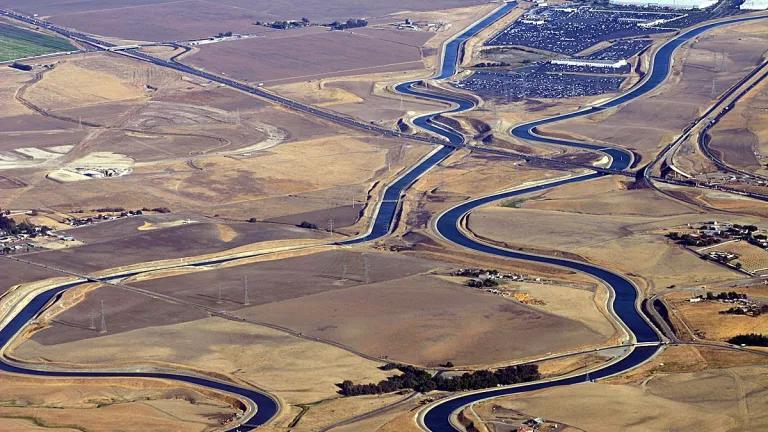Reducing Water Loss Requires Upgrading Aging Ag Water Infrastructure
California’s ag sector will continue to struggle with unsustainable water use until it addresses broader inefficiencies across its aging water delivery system.

Aerial photo of the California Aqueduct at the Interstate 205 crossing, just east of the Interstate 580 junction.
Ian Kluft, 11 September 2007
This blog was written by guest author, Gillian Roy, who was a 2023 Schneider Fellow from Stanford University. Gillian is graduating in 2024 with a degree in Earth Systems.
California owes much of its success as the nation’s leading agricultural producer to the vast systems of irrigation that supply water to the state’s agricultural land. Every year, California irrigates an average of more than nine million acres of agricultural farmland using roughly 34 million acre-feet of water–roughly 80% of all water used for homes, businesses, and agriculture in California.

The California Aqueduct as it emerges from Bethany Reservoir in eastern Alameda County, California.
Photographer John Loo on 14 July 2007
However, climate change is fueling more severe and longer-lasting droughts in California, threatening the economic and environmental viability of the state’s irrigation-reliant agricultural sector. To address this challenge, state and federal government grant programs (such as NRCS’s EQIP WaterSMART Initiative and the CDFA SWEEP grant) incentivize California’s farmers to install technologies that improve water use efficiency on their farms, like drip irrigation systems and advanced irrigation scheduling. While these on-farm upgrades are important, they alone are not enough to ensure the entire agricultural sector uses water efficiently during drought periods. To maximize the state’s water use efficiency, irrigation districts must invest in upgrades to their water management systems and services to complement farmers’ investments in their on-farm irrigation systems.
California’s agricultural sector needs to address the broader inefficiencies of its aging water delivery system–the complex network of canals, pipes, reservoirs, and pumps that move water from wetter Northern California to the drier Central Valley and Southern California.

Surface irrigation system using siphon tubes.
2000. Photo by Dan Ogle, USDA Natural Resources Conservation Service.
Most of California’s water delivery infrastructure was built during the 20th century– meaning it was designed and constructed at a time when water supplies were more abundant and reliable. The current water delivery system mostly features open gravity-fed canals, limited real-time metering, and manually operated gates and valves. This existing infrastructure causes significant spillage, seepage, and evaporation of water from the conveyance and distribution networks.
Moreover, the system’s outdated infrastructure requires that water deliveries be planned significantly in advance. This is incompatible with the more on-demand water supply required by modern on-farm precision irrigation systems and management practices, which are currently incentivized by state and federal funding. Ultimately, the discrepancy between water deliveries and demands results in increases in groundwater pumping to meet water needs.
Upgrades to California’s water delivery system, such as lining canals to reduce seepage, pressurizing water delivery pipes, installing real-time metering, and automating water delivery software and farmgate operations, can greatly improve water use efficiency and water productivity, while helping reduce the state’s water stress. In one example of a water delivery system modernization project, the South San Joaquin Irrigation District’s (SSJID) Irrigation Enhancement Project involved installing 19 miles of pressurized pipelines, automatic flow control valves and magnetic flow meters at turnouts, soil moisture sensors on farms, and online water ordering software. The Irrigation Enhancement Project helps SSJID implement volumetric pricing, track water usage, and provide growers with real time and historical data that can be used for planning and evaluation while also preventing groundwater pumping in the district’s service area. According to one estimate, these improvements reduced groundwater pumping by 12,500 acre feet, and if these modernizations are made throughout SSJID’s service area, consultants estimate the District can conserve more than 73,000 acre feet of water. “The use of these <modernization> systems has increased over time and is anticipated to continue to increase in the future,” writes SSJID.
Despite the significant potential water loss reductions and water productivity gains of these types of infrastructure and operational upgrades, they remain underfunded. One national survey found that more than 75% of irrigation districts cited financial constraints as a major impediment to implementing water-conserving delivery system upgrades. Adding to this challenge, funding from state and federal grants to support upgrades to water delivery systems has been limited, especially in comparison to the financial assistance available for on-farm water efficiency improvements. This predicament is best demonstrated by the funding history of federal Conservation Innovation Grants–one of the few grants capable of financing both on-farm water use efficiency improvements and water delivery system upgrades. From 2012 to 2022, roughly 12% of CIG funding was used to support a total of 56 projects that implemented on-farm water use efficiency improvements like the installation of sensor-based irrigation scheduling technologies. Over the same period, CIG financed only three water delivery system upgrades–accounting for just 0.3% of available funds.
While programs that provide financial assistance to improve on-farm water use efficiency are a necessary part of California’s agricultural drought resilience strategy, these on-farm improvements are hamstrung by systemic issues with California’s inefficient and outdated water delivery system. Therefore, we need significant and reliable investments in irrigation-district level infrastructure so that California’s farmers can proactively plan for and work within a future with more limited, increasingly variable water supplies.




